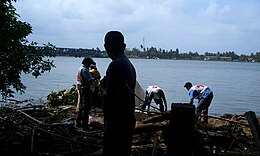Effect of the 2004 Indian Ocean earthquake on Sri Lanka

Red Cross volunteers removes corpse from the shore
|
|
| Date | 26 December 2004 |
|---|---|
| Magnitude | 9.1 |
| Depth | 30 |
| Epicenter | Indonesia |
| Casualties | 30,196 confirmed dead, 21,411 injured |
Sri Lanka was one of the countries struck by the tsunami resulting from the Indian Ocean earthquake on December 26, 2004. On January 3, 2005, Sri Lankan authorities reported 30,196 confirmed deaths
Many of the dead were adults and the elderly. The south and east coasts were worst hit. One and a half million people were displaced from their homes. The death toll continued to rise as the threat of infectious diseases breaking out turned into a reality, with doctors confirming first cases of cholera.
In the eastern Sri Lankan Ampara District alone, more than 5,000 people died. A holiday train, the "Queen of the Sea", was struck by the tsunami near the village of Telwatta as it travelled between Colombo and Galle carrying at least 1,700 passengers, killing all but a handful on board. About 1,000 more dead were counted in Mullaitivu and Vadamaradchi East. At Trincomalee in the northeast, where the tsunami reached more than 2 km (1.25 mi) inland, 800 were reported dead. About 69 dead were counted at Batticaloa in the east. The naval base at Trincomalee was reported to be submerged.
The agricultural sector was affected seriously. 259 km² of paddy land was destroyed in the northern, eastern, southern and western coastal belts. In addition, the extensive salinization of paddy lands rendered them unsuitable for paddy cultivation. Rubbish was also deposited on paddy lands. A large number of agricultural vehicles and equipment were destroyed and canals and drains were blocked. Underground sources of water were salinated.
Across the island, collections were taken for those who had lost everything. Vans with PA systems drove around calling on people to give whatever they could – money, clothes, bottles of water and bags of rice and lentils.
...
Wikipedia
